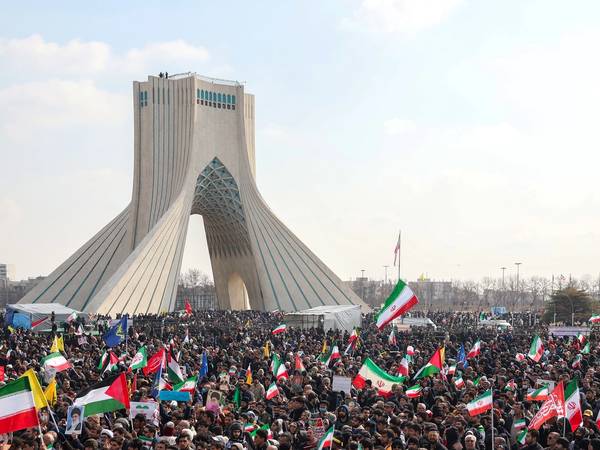On Monday, the Iranian state marked the 46th anniversary of the Islamic Revolution, set against the backdrop of controversies surrounding potential talks with the United States, mounting public discontent and a deepening economic crisis.
The event typically features state-sponsored rallies across the country, a speech by the president at Tehran’s Azadi Square, and a participants’ resolution issued by the Islamic Propaganda Coordination Council, which is read at the conclusion of events in Tehran and other cities.
High-ranking officials, such as the heads of the executive, legislative, and judiciary branches, as well as military leaders, take part in these rallies.
This year, state-run television channels aired fewer aerial shots of the rallies, which in previous years had been used to showcase large crowds. The coverage appeared more restrained, reflecting the multiple international, political, and economic challenges facing Tehran.
The national currency, the rial, has been in freefall, losing over 10 percent of its value against the US dollar in four days, since Supreme Leader Ali Khamenei’s speech on February 7, in which he strongly rejected the prospect of talks with the US.
Many Iranians fear further depreciation of the rial before the Iranian New Year (March 20), unless there is a breakthrough in negotiations to revive the 2015 nuclear deal—abandoned by former US President Donald Trump in 2018—or to secure a new agreement. The potential reinstatement of UN sanctions in October through the snapback mechanism has only intensified these concerns.
Public protest amid state celebrations
On Sunday evening, as state-organized fireworks lit up Tehran, citizens in several neighborhoods across the east, west, and south of the capital, as well as in other major cities, chanted slogans from their windows and rooftops.
These included "Death to the Islamic Republic," "Death to Khamenei the Murderer," and "Death to the Dictator."
The chants echoed the widespread protests of 2022-2023, sparked by the death of 22-year-old Mahsa Jina Amini in the custody of the so-called morality police. Those protests, carried out under the banner "Woman, Life, Freedom," were brutally suppressed by state forces.
While the state-run television channels, as always, provided extensive coverage of the anniversary marches and speeches, claiming millions of participants, photos and videos shared on social media suggested a significantly smaller turnout compared to previous years.
Pezeshkian’s speech fails to inspire
Some social media users expressed disappointment with President Masoud Pezeshkian’s speech, criticizing it for failing to address pressing public concerns. Many suggested that, had his ultra-hardline rival Saeed Jalili been elected president, his remarks might have closely resembled Pezeshkian’s.
In his address, the president reiterated allegiance to Supreme Leader Khamenei’s leadership, accusing "enemies" of attempting to create divisions among Iranians and portraying the country as weak. He also strongly criticized the US President Donald Trump and accused him of hypocrisy, claiming Trump simultaneously increased pressure on Iran while offering to negotiate and trying to "bring the Islamic Revolution down to its knees."
“Trump says, ‘Let’s negotiate,’ but signs [a document containing] all possible schemes against Iran, then claims he is ready to talk,” Pezeshkian said.
The president also criticized the US for supporting Israeli Prime Minister Benjamin Netanyahu, whom he referred to as “a criminal indicted by international organizations,” referencing the International Criminal Court’s arrest warrant issued for Netanyahu in November 2024.
